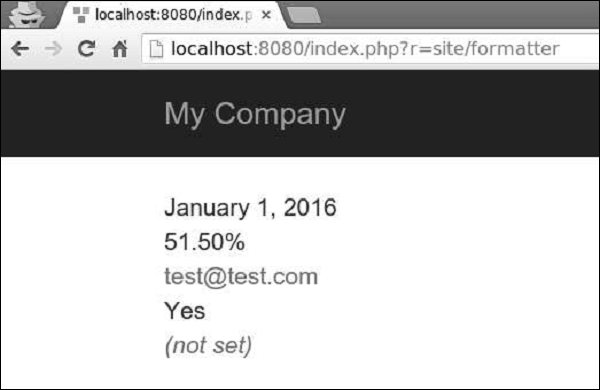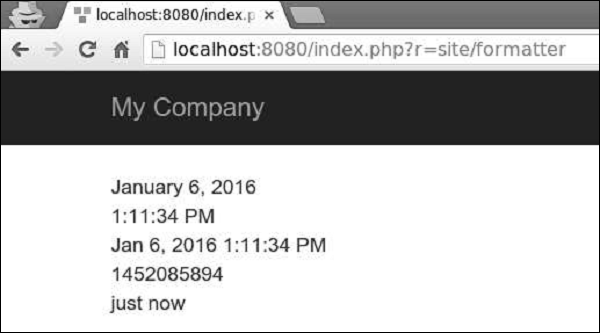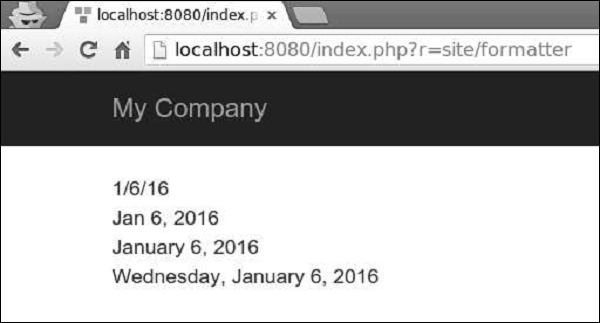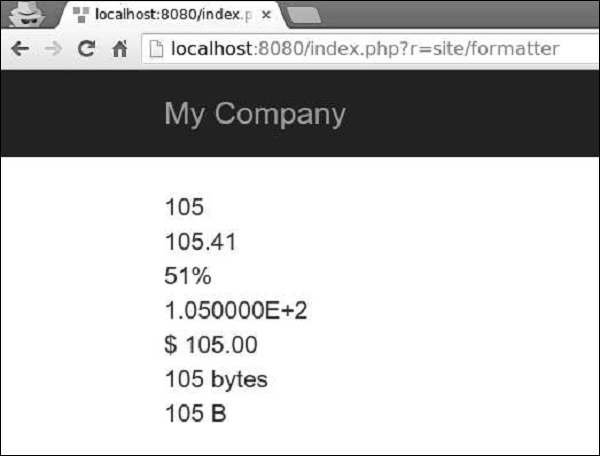
- Yii - Home
- Yii - Overview
- Yii - Installation
- Yii - Create Page
- Yii - Application Structure
- Yii - Entry Scripts
- Yii - Controllers
- Yii - Using Controllers
- Yii - Using Actions
- Yii - Models
- Yii - Widgets
- Yii - Modules
- Yii - Views
- Yii - Layouts
- Yii - Assets
- Yii - Asset Conversion
- Yii - Extensions
- Yii - Creating Extensions
- Yii - HTTP Requests
- Yii - Responses
- Yii - URL Formats
- Yii - URL Routing
- Yii - Rules of URL
- Yii - HTML Forms
- Yii - Validation
- Yii - Ad Hoc Validation
- Yii - AJAX Validation
- Yii - Sessions
- Yii - Using Flash Data
- Yii - Cookies
- Yii - Using Cookies
- Yii - Files Upload
- Yii - Formatting
- Yii - Pagination
- Yii - Sorting
- Yii - Properties
- Yii - Data Providers
- Yii - Data Widgets
- Yii - ListView Widget
- Yii - GridView Widget
- Yii - Events
- Yii - Creating Event
- Yii - Behaviors
- Yii - Creating a Behavior
- Yii - Configurations
- Yii - Dependency Injection
- Yii - Database Access
- Yii - Data Access Objects
- Yii - Query Builder
- Yii - Active Record
- Yii - Database Migration
- Yii - Theming
- Yii - RESTful APIs
- Yii - RESTful APIs in Action
- Yii - Fields
- Yii - Testing
- Yii - Caching
- Yii - Fragment Caching
- Yii - Aliases
- Yii - Logging
- Yii - Error Handling
- Yii - Authentication
- Yii - Authorization
- Yii - Localization
- Yii - Gii
- Gii – Creating a Model
- Gii – Generating Controller
- Gii – Generating Module
Yii - Formatting
To display data in a readable format, you can use the formatter application component.
Step1 − Add the actionFormatter method to the SiteController.
public function actionFormatter(){
return $this->render('formatter');
}
In the above code, we just render the formatter view.
Step 2 − Now, create a formatter.php view file inside the views/site folder.
<?php
$formatter = \Yii::$app->formatter;
// output: January 1, 2016
echo $formatter->asDate('2016-01-01', 'long'),"<br>";
// output: 51.50%
echo $formatter->asPercent(0.515, 2),"<br>";
// output: <a href = "mailto:test@test.com">test@test.com</a>
echo $formatter->asEmail('test@test.com'),"<br>";
// output: Yes
echo $formatter->asBoolean(true),"<br>";
// output: (Not set)
echo $formatter->asDate(null),"<br>";
?>
Step 3 − Go to http://localhost:8080/index.php?r=site/formatter, you will see the following output.

The formatter component supports the following formats related with date and time −
| Output format | Example |
|---|---|
| date | January 01, 2016 |
| time | 16:06 |
| datetime | January 01, 2016 16:06 |
| timestamp | 1512609983 |
| relativeTime | 1 hour ago |
| duration | 5 minutes |
Step 4 − Modify the formatter view this way.
<?php
$formatter = \Yii::$app->formatter;
echo $formatter->asDate(date('Y-m-d'), 'long'),"<br>";
echo $formatter->asTime(date("Y-m-d")),"<br>";
echo $formatter->asDatetime(date("Y-m-d")),"<br>";
echo $formatter->asTimestamp(date("Y-m-d")),"<br>";
echo $formatter->asRelativeTime(date("Y-m-d")),"<br>";
?>
Step 5 − Type http://localhost:8080/index.php?r=site/formatter in the address bar of your web browser, you will see the following output.

Date Formats
There are also four date format shortcuts: short, medium, long, and full.
Step 1 − Modify the formatter view file this way.
<?php
$formatter = \Yii::$app->formatter;
echo $formatter->asDate(date('Y-m-d'), 'short'),"<br>";
echo $formatter->asDate(date('Y-m-d'), 'medium'),"<br>";
echo $formatter->asDate(date('Y-m-d'), 'long'),"<br>";
echo $formatter->asDate(date('Y-m-d'), 'full'),"<br>";
?>
Step 2 − If you go to the web browser and type http://localhost:8080/index.php?r=site/formatter, you will see the following output.

Number Formats
The formatter component supports the following formats related with numbers −
| Output format | Example |
|---|---|
| integer | 51 |
| decimal | 105.51 |
| percent | 51% |
| scientific | 1.050000E+2 |
| currency | $105 |
| size | 105 bytes |
| shortSize | 105 B |
Step 1 − Modify the formatter view this way.
<?php $formatter = \Yii::$app->formatter; echo Yii::$app->formatter->asInteger(105),"<br>"; echo Yii::$app->formatter->asDecimal(105.41),"<br>"; echo Yii::$app->formatter->asPercent(0.51),"<br>"; echo Yii::$app->formatter->asScientific(105),"<br>"; echo Yii::$app->formatter->asCurrency(105, "$"),"<br>"; echo Yii::$app->formatter->asSize(105),"<br>"; echo Yii::$app->formatter->asShortSize(105),"<br>"; ?>
Step 2 − Go to http://localhost:8080/index.php?r=site/formatter, you will see the following output.

Other Formats
Yii also supports other formats −
text − The value is HTML-encoded.
raw − The value is outputted as is.
paragraphs − The value is formatted as HTML text paragraphs wrapped into the p tag.
ntext − The value is formatted as an HTML plain text where newlines are converted into line breaks.
html − The value is purified using HtmlPurifier to avoid XSS attacks.
image − The value is formatted as an image tag.
boolean − The value is formatted as a boolean.
url − The value is formatted as a link.
email − The value is formatted as a mailto-link.
The formatter may use the currently active locale to determine how to format a value for a specific country.
The following example shows how to format date for different locales.
<?php
Yii::$app->formatter->locale = 'ru-RU';
echo Yii::$app->formatter->asDate('2016-01-01'); // output: 1 2016 .
Yii::$app->formatter->locale = 'de-DE';
// output: 1. Januar 2016
echo Yii::$app->formatter->asDate('2016-01-01');
Yii::$app->formatter->locale = 'en-US';
// output: January 1, 2016
echo Yii::$app->formatter->asDate('2016-01-01');
?>